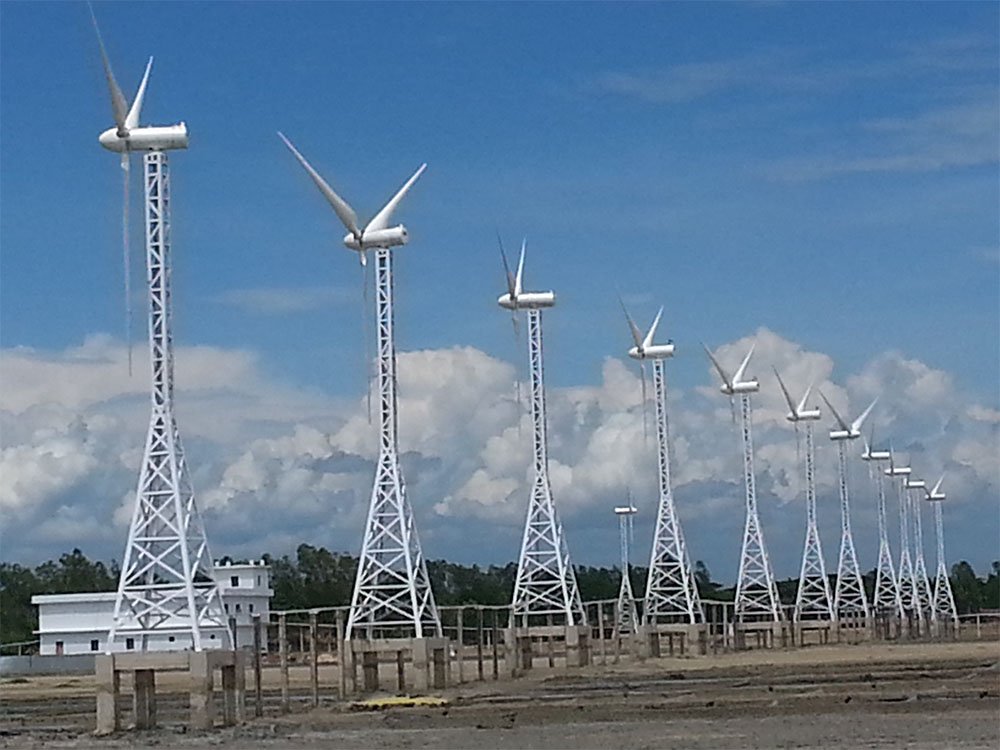
Bangladesh is a relatively smaller country with around 160 million people. We have the highest population density in the world. Every inch of land is cultivable and important for us. Land shortage is the biggest problem for any type of installations in Bangladesh. We do not have any barren land and we do not have any desert. All are agricultural lands. In terms of land availability, our situation is unique and cannot be flatly compared with the situation of India or China or any other country. We do not have enough resources or scopes for the installations of floating solar PV or elevated SPV power plants. One MW solar PV power plant needs 3-5 acres of valuable land. Particularly, this point of solar PV power plant needs re-thinking.
According to the national energy policies (conventional & renewable), the government must generate 10% of its power from renewable resources by 2020. Currently, Bangladesh is generating around 550 MW of its electricity from renewables, which is just 2.95% of total power generation. It is not possible to generate 2,000 MW of power—which is 10% of the total national installed capacity within only two years.
Only Solar PV Cannot Achieve This Target
We are imparting all of our efforts and resources towards solar power. As if we want to achieve our 100% renewable energy target only from solar power. All government activities are concentrated only on solar power. But it is not at all possible to achieve our renewable energy goals only with solar energy. We do not have enough land to be used for large solar PV power plants.
Must Look for Other Renewable Energy Resources
Wind energy is the fastest growing renewable energy resource in the world. It is also the cheapest renewable energy source. The most important advantage of wind energy is that it requires very little amount of land. The wind energy site areas can be used for agricultural and other purposes. Wind turbines can also be installed in the Bay of Bengal (offshore wind power plants).
People are spreading the false news that there is not enough wind for running the commercial wind turbines in Bangladesh. But recently one study conducted by NREL of the USA concluded that Bangladesh has about 30,000 MW of wind energy potentials. NREL is not a Bangladeshi company and this is not found out by the Bangladeshi people like me. This has been found out by the NREL’s white-skinned highly-skilled experts and consultants. We must have these good potentials of wind energy. We must not ignore these potentials any more. We must have to pour our efforts and resources towards wind energy also.
Natural Coincidence of Wind Season and Peak Demand Season in Bangladesh
In Bangladesh, the wind season or the summer season is from March to September. This is also the Summer-Peak-Demand season for electricity. This is a natural coincidence. During this Summer Season, wind speeds are very good. But during the Winter Season, wind speeds are not good. When the average wind speeds are calculated, the average annual wind speed values come down. During the Summer-Peak-Demand, our country suffers economic losses due to power shortages which is caused by the sudden increase of power demands. This sudden increase in power demand can be substantially satisfied from the good winds available during this Summer Season.
Low Wind Turbines and Bangladesh Perspective
Many major wind turbine manufacturers are already marketing low wind speed wind turbines for low wind speed areas. These low wind regime turbines have cut-in wind speeds as low as 2.0 m/s. Their design wind speed for maximum output is 9 to 10 m/s. These low wind turbines are very efficient at low wind sites/areas/regions. These wind turbines are expected to open up new markets in the whole world. Additionally, turbines designed for low wind speed can also be ideally located close to population centers. These new low-wind speed design is expected to lower cost of energy by as much as 10 to 15% compared to the available conventional wind turbines, increasing its competitiveness with traditional fossil fuels. Low wind speed turbines near urban centers can reduce the bottlenecks on the transmission system that can be caused by the long-distance transmission of electricity. With these low wind turbines, wind energy is likely to become suitable, technically feasible and economically viable for all over Bangladesh.
Offshore Wind Energy Potentials in Bangladesh
We have vast areas in the Bay of Bengal. There are lots of valuable economic resources in this blue sea area. We are all talking about the exploration of all economic potentials of this blue sea (i.e. blue economy). Offshore wind energy may be an important part of this blue economy. We can install large scale wind turbines in the Bay of Bengal. All wind energy harnessing countries are putting more and more resources towards their offshore wind energy potentials. Offshore wind is one of the most appropriate and most suitable renewable energy resources for Bangladesh because of its limited land availability. The global offshore wind market saw the deployment of 4,988 MW in 2018, which made the year a record one in terms of new capacity additions, shows data released by the World Forum Offshore Wind (WFO). The cumulative installed offshore wind capacity increased to 22,045 MW at end-2018. By going offshore, we can avoid occupation of our valuable agricultural lands by the renewable energy power plants. I would like to strongly request the energy sector policymakers to install at least ten 150-meter high wind measuring masts in the off shore areas of the Bay of Bengal as soon as possible.
![]()
The World Forum for Offshore Wind (WFO) in predicting the addition of further 500 GW of offshore wind parks by 2050 under their Mission "500 by 50". On the basis of the calculations conducted by the International Renewable Energy Agency (IRENA), which says offshore wind has the potential to reach 520 GW by 2050. WFO noted that such “steep” growth could be only achieved through extensive cooperation between the offshore wind community and governments and regulators.
Worldwide Wind and Solar Installations in 2018 & 2019 (forecasts)
|
Wind & Solar (worldwide) |
Wind Total Capacity |
Wind New Installations |
Solar Total Capacity |
Solar New Installations |
|
2019 Forecast: |
655.9 GW |
65.4 GW |
646.8 GW |
137.5 GW |
|
2018 Preliminary: |
591.5 GW |
51.3 GW |
509.3 GW |
102.4 GW |
|
2017-2018 Change |
Increase by 10.9% |
Increase by 27.4% |
Increase by 27.0% |
Increase by 34.3% |
What Other Countries Are Doing?
The overall capacity of all wind turbines installed worldwide by the end of 2018 reached 597 Gigawatt, according to preliminary statistics published by WWEA. Around 50,100 Megawatt were added in the year 2018, slightly less than in 2017 when 52,552 Megawatt were installed. The year 2018 was the second year in a row with growing number of new installations but at a lower rate of 9.1%, after 10.8% growth in 2017. All wind turbines installed by end of 2018 can cover close to 6% of the global total energy demand.
We can see in the above figures that wind and solar energies are moving parallel in all other countries of the world. Wind and solar are going neck and neck. Only one resource alone cannot satisfy the requirements or targets or goals of any country. It is not at all possible. China installed 44.4 GW of PV in 2018. In 2018, China was by far the largest wind energy nation by both new installed capacity (23.0 GW) and total capacity (211.4 GW). USA: In second place, the United States boasts 96.7 GW of total wind power capacity by the end of 2018 - ahead of Germany (59.3 GW), India (35.1 GW), Spain (23.5 GW), and United Kingdom (21.0 GW). Among the top 20 countries by total wind power capacity in 2018, the fastest growing by new installations were Mexico (+0.9 GW / +23.2%), Brazil (+1.9 GW / +15.2%), China (+23.0 GW / +12.2%), France (+1.6 GW / +11.3%), and Sweden (+0.7 GW / +10.6%).

In Bangladesh: Light at the End of the Tunnel
In Bangladesh, we have installed, till to date, only 5MW of wind power. In 1991, India was at 500MW and China was nil. Now, India has installed 35,000MW and China has installed 215,000MW. But our achievement is only 5MW.
But after the release of the Wind Study Report by NREL, USA, there is a light at the end of the tunnel. BPDB has floated three international tenders for 50MW each wind power plants as IPPs at three locations in Bangladesh. These will be grid connected Independent Power Producers with private investments. Hopefully, after these three tenders, more and more tenders will come.
Conclusion
In the world, a renewable energy technology revolution is going now. Renewable Energy Technologies (RET) are changing and improving every day. We must have to keep pace with these RET revolutionary changes and improvements. We are lagging far behind in adopting these clean and environment-friendly energy resources. Lagging behind is not always bad. Now, we can get much better, highly efficient and intelligent technologies at our door steps with much lower prices. We must have to pay equal importance and emphasis on wind, solar and other renewable energy sources. Only one resource can never be able to fulfill our renewable energy targets/goals. Offshore wind can play a very important role in our national energy mix. Low wind regime turbines are most likely to make wind energy technically feasible and economically viable all over Bangladesh.
Md. Fazlur Rahman;
Renewable Energy Consultant, Dhaka, Bangladesh



